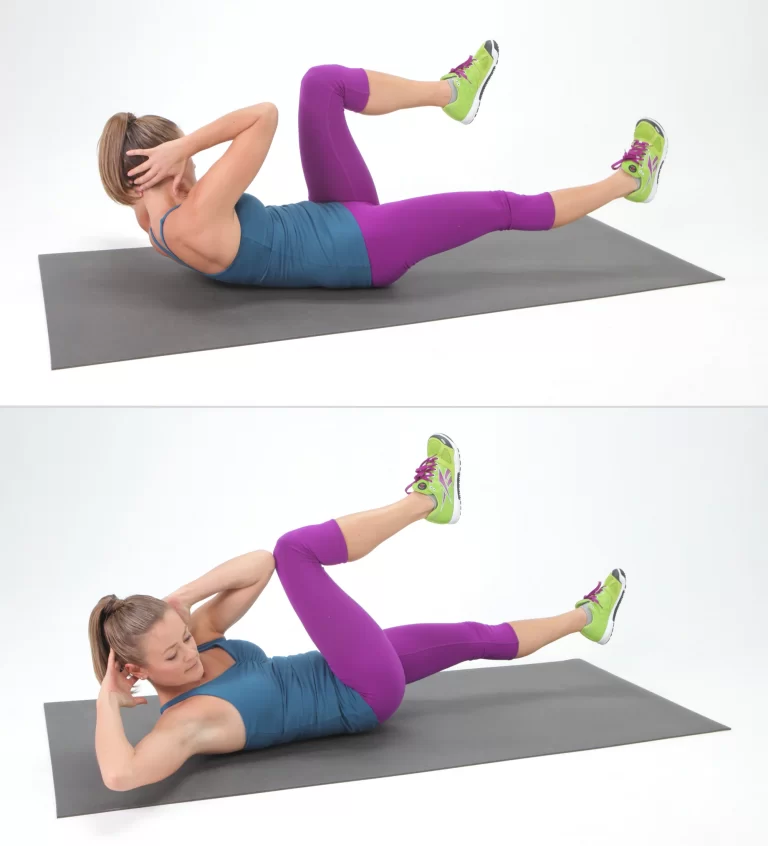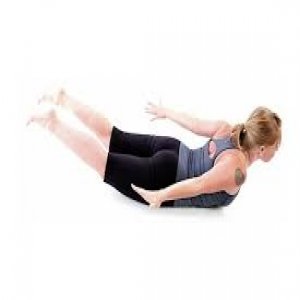12 Best Long Head Biceps Exercises to Build Mass and Strength
Introduction
The long head of the biceps brachii is one of the key muscles of the upper arm, contributing significantly to the overall arm strength and aesthetic appearance. A well-developed long head of the biceps not only enhances the overall arm definition but also plays a crucial role in various upper-body movements. To effectively target and develop the long head of the biceps, a variety of exercises can be incorporated into a comprehensive workout routine.
The bicep brachii is a single muscle on the front side of the upper arm that is split into a short and a long head. The long head of the bicep is an essential muscle head when it comes to power and aesthetics. It is the muscle at the external part of the upper arm. A well-strength, bicep muscle will consistently make you stand out.
When performing to raise the strength of the biceps, strengthening the long head is important. An amazing bicep peak is the ultimate attraction for bodybuilders, and men in general, which is why the long head is so frequently discussed among professionals and fitness fanatics alike.
While both bicep heads work together in most workout conditioning, it is important to understand how to determine the two during training so you can develop both heads to the most amazing potential.
The long head is the larger and more major of the two bicep heads. This indicates that it does require some additional focus when training the biceps. Moreover, it is usually not as developed as it should be in simple lifters. The short head deserves a special watch too. In nature, you want to know how to best target both the long head and short head. By understanding how to sharpen in on the individual heads, you can give your biceps that long and high-extreme look, as well as thickness.
If your bicep is lacking “peak”, then you require to learn how to beat the long head better. It is not all about doing more reps or using heavyweight, it is about movement variables like position, grip width, arm position, and overall which exercises you are doing, albeit reps, loads, and volume do play a very important role.
Anatomy and action of the Biceps Brachii Muscle
Three muscles are located in the anterior compartment of the upper arm: the brachialis, coracobrachialis, and biceps brachii. The biceps brachii are located in the front, while the coracobrachialis and brachialis are under the biceps.
The bicep is the only muscle on the front side of the upper arm formed of a short head (caput breve) and a long head (caput longum).
While the short head is reliable for the width and fullness of the anterior part of the upper arm, the long head makes the peak that makes for a taller-looking and well-developed bicep during elbow flexion.
Both heads arise from the scapula and join from different points. The short head begins at the top of the coracoid process, and the long head attaches to the supraglenoid tubercle of the scapula.
Regardless, they join as one muscle belly along the upper arm before tapering and inserting into the same area at the anterior part of the elbow. When the elbow is pushed behind the body, the long head stretches and can supply maximal force due to the length-tension association of the skeletal muscle.
The actions of these two heads of the bicep are to move the forearm towards the upper arm (elbow flexion) and rotate the forearm outward (supination). The long head helps in the dynamic strength of the shoulder joint (glenohumeral) in the initial thirty degrees of elevation.
Is it possible to separate the biceps long head?
You can not fully isolate the long head of the bicep, but you can complete certain exercises to utilize the long head. Essentially, both heads will be started during any bicep workout no matter what, but certain activities can activate one head more than the other.
Therefore, pay close awareness to the movements in this long-head bicep guide. Before we reach into the exercises, let’s go over the training variables that allow you to hone in on the long head of the bicep. By learning this, you will know exactly why we tag the exercises to reach as long head bicep training.
Benefits of Training Your Biceps
- Build bigger arms
- Healthy elbow flexion
- More comfortable doing everyday chores
Taking everything we have already covered, it should be relatively easy to determine some major advantages that come from training your biceps. Firstly, you will grow the muscle, which is in line with what most people consider to be perfect physique purposes. But it is more than just about looks healthy elbow flexion will allow you to do more than you might anticipate, from pulling grocery bags to picking up your kids.
What exercise acts on the long-head biceps peak?
Multiple exercises highlight the long head of the bicep. Many of them you probably already know, but maybe you did not recognize they are best for the long head. The good news is, that it is not hard to hit the long head. It’s not as though you have to establish some bizarre mind-muscle link. All you have to do is execute the above techniques.
The following all act on the techniques we just went over. In taking you through these exercises that best activate the long-head bicep, we will try to be as descriptive as possible for the sake of clarity.
Incline Dumbbell Curls
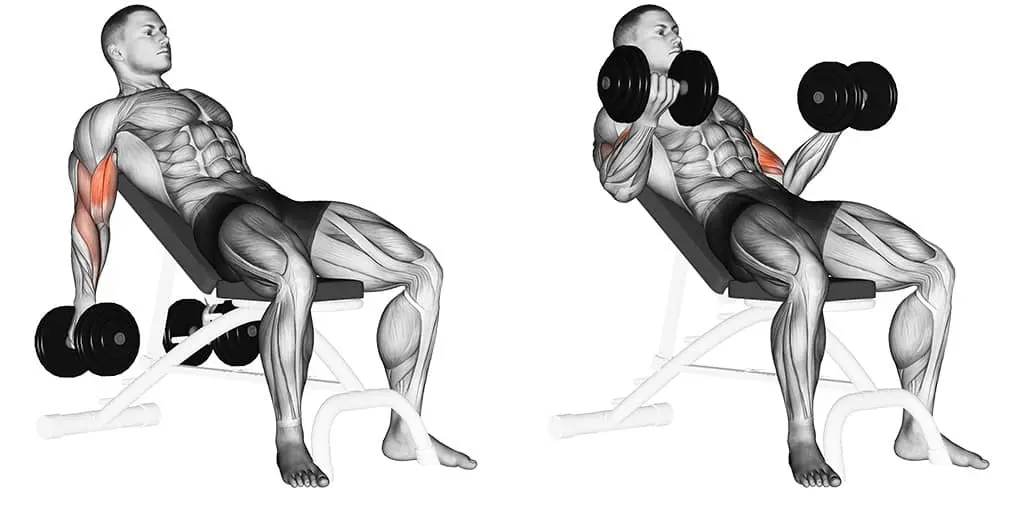
The ideal workout for building long-head biceps is the inclined dumbbell curl. Stretching at the bottom of the exercise and positioning it for maximum force production at the top are two ways it trains the long head of the biceps. Throughout the exercise, the long head of the biceps had the most EMG activity during incline dumbbell curls, according to the research. A huge peaked bicep can be developed with this full-range workout, which is quite effective.
How To Do
- Position a 45-degree incline bench and place your back firmly against it.
- With your hands facing up, take hold of a set of dumbbells and hold them at arm’s length at your sides.
- As you raise the dumbbells to your shoulders, release your breath.
- Remain bent with your elbows close to your body and do not swing or jerk.
- Squeeze the muscle for a short while after you’ve reached the peak of the exercise.
- Return the dumbbells to their starting position slowly. As you inhale, do this.
- Keep the dumbbells in your full range of motion and resist the urge to let them fall too quickly.
- For the required amount of repetitions, repeat.
Tips
- It is preferable to begin with a lower weight and raise it gradually as your strength improves.
- Use the entire range to develop longer biceps.
Close Grip Barbell Curl
This exercise is a highly recognizable biceps workout that strengthens the biceps Peak. It is a great exercise for catching results in strength and definition. It is an overall great bicep exercise. This is a simple and effective exercise, that targets your biceps, resulting in bigger and more powerful guns. While a narrow grip arks the outer biceps (long head), a broad grip focuses effort on the inner biceps (short head).
How To Do
- Grab the barbell with a close grip (it can be hip-width or closer). Position your palms upwards and slightly apart.
- Your legs should be shoulder-width. your trunk should be straight and your head up, and your elbows can be held close to your trunk.
- Curl the barbell up to shoulder level by flexing your elbows. Maintain the contraction for five seconds.
- Gradually lower the barbell back down and the arms should be straight.
- Repeat for the 10 to 15 repetitions of 2 sets.
Tips
- Your body should remain stable. Only the bicep muscle can be used to move the weight.
- Hold at the top motion and contract your biceps.
- The movement should occur at the elbow to separate the biceps, not on the shoulders.
Concentration Curl
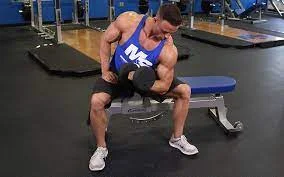
This is a wonderful exercise to build up your biceps. Your arm workout regimen should include this training. It is also a wonderful way to target the long-head muscles as you are going to be focusing on the peak and trying to “blow” it up. Relaxing the upper arm against the thigh controls movement at the shoulder and is an amazing way to isolate the biceps. End the action completely supinated again, the pinky should be pointing in the upward direction.
How To Do
- Flex down from your trunk hold a dumbbell in your hand and rest your other arm on your knee.
- Bend your arms to the maximum and twist your wrist so that the little finger is at a lower level than the thumb. Curl the dumbbell back to the beginning position.
- For ten to fifteen repetitions, repeat.
Tips
- To maintain tension in the biceps, keep the elbow slightly bent at the bottom of the exercise.
- Tension and the mind-muscle connection can be enhanced by doing the exercise’s slow eccentric (lowering) phase.
Hammer Curl
This is a classic weightlifting movement that targets the biceps and forearms. It is also an effective isolation movement that targets the forearm muscles. When it comes to creating muscular hypertrophy and strength, hammer curl training is one of the most popular activities among bodybuilders and regular weightlifters.
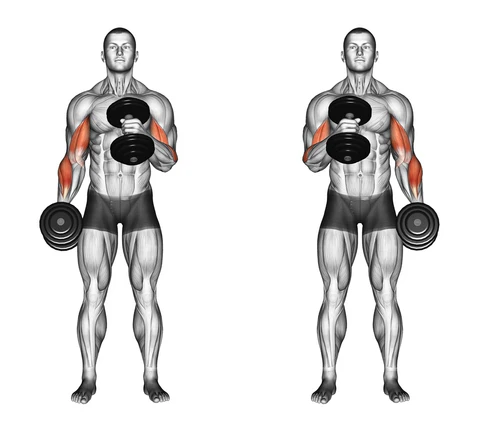
How To Do
- To begin this exercise Stand with your feet shoulder-width apart and slightly flex your knees.
- Grab a pair of dumbbells in your hands with your palms facing towards your body.
- Holding your elbows close to your body, gradually curl the dumbbell up to your shoulders.
- hold for a second at the top of the lift, constrict your biceps, and then lower the weights under control.
Tips
- Lift and lower the dumbbell gradually. Keep in control of using your strength, not using speed or gravity.
- Neither tilt back as you raise the weight nor lean forward as you lower it.
Behind The Back Cable Curl (Bayesian Curl)
Your arms will be bending with your elbows behind you, which highlights the long head. Accomplishing cable curls behind the body shifts the emphasis of the exercise onto the outer biceps and reduces the chance of developing unappealing muscular imbalances.
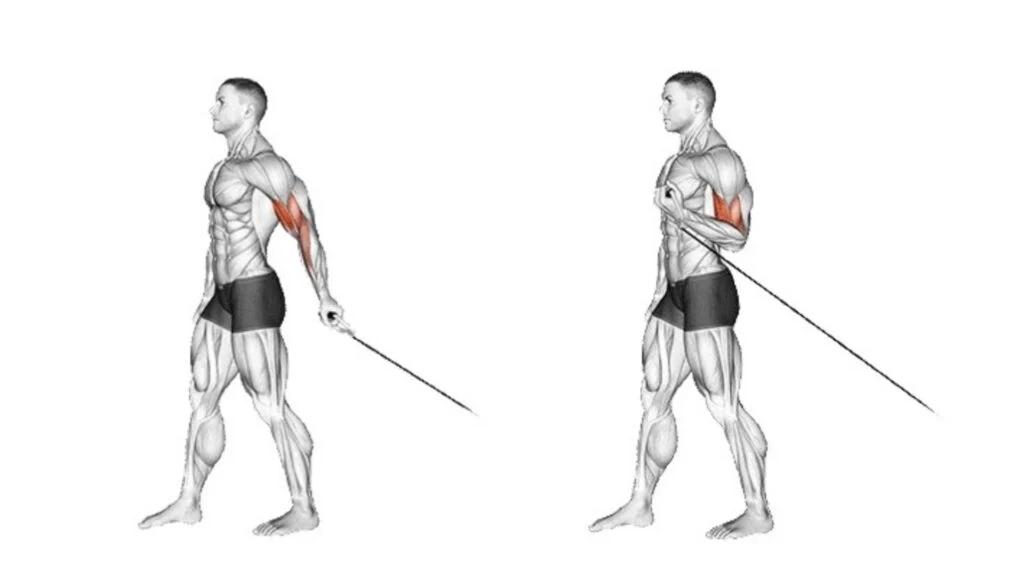
You may ensure that each bicep is receiving roughly equal amounts of work and developing roughly in proportion by training each arm independently.
How To Do
- A cable pulley’s bottom can be fitted with a single cable handle.
- Grasp the handle with an underhand grip and then face away from the machine.
- Take a step out from the cable station and let your arm travel behind your trunk until you feel a good biceps stretch.
- Curl the handle toward your shoulder by pressing your biceps as hard as you can.
- Drop the weight back down under control until your elbow is fully extended.
- Repeat for the 10 reps for 2 sets.
- Now, switch arms to do the exercise on your right side, and then alternate between arms for sets.
Tips
- The arm is positioned and maintained behind the body throughout the whole range of movement.
- It is important to keep in mind that the elbow should be indicating backward at the end of the move as it was at the beginning.
Close Grip Preacher Curl
The biceps can have either a long muscle or a long tendon, and their shape is inherited. If you have a lengthy tendon, then the preacher curl is a great exercise to build a long biceps head and get a full biceps pump. To complete this exercise, use an E-Z curl bar or barbell while seated on a preacher’s bench.
How To Do
- To start this exercise you have to sit on the Preacher Bench with your chest against the support.
- Grab the barbell with a close grip (it can be hip-width or closer).
- Curl the barbell as in a standard barbell curl and get maximum contraction at the top.
- Dropping the barbell gradually gives consistent stress throughout the movement.
- Lowers the barbell to get the maximum extension.
- Repeats the 10 to 15 repetitions of 2 to 3 sets.
Tips
- Do not raise off the back. Utilize your biceps only.
- Throughout the set, maintain a controlled and slow.
- Press the biceps as hard as possible as you get the weight to the top.
- Utilize a wide grip to work the internal biceps and a close grip to work the outer biceps.
Dumbbell Drag Curl
This is a unique bicep curl exercise in which you do not completely bring the weight in front of your body. Thus, you have a more difficult time turning and using momentum to get the weight up.
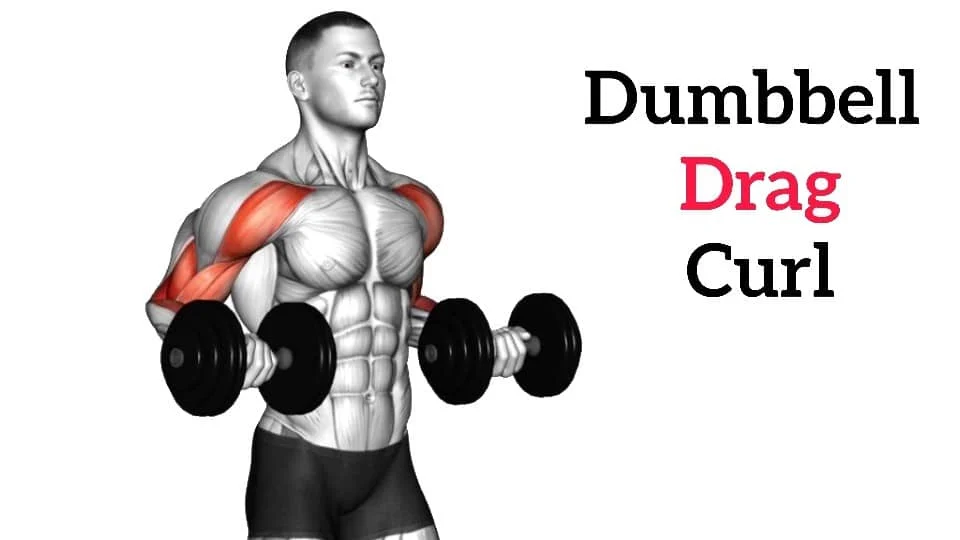
Because of the elbow position, the long head of the bicep is highlighted the greatest. Curling up causes your elbows to pull back behind you, stretching and greatly increasing the length of your head. To get the same results for this exercise, you can use an EZ bar, dumbbell, or barbell.
How To Do
- Stand with your feet shoulder-width apart, your knees slightly flexed and your abdominals drawn in.
- Hold the dumbbell with a double underhand (supinated) grip with your hands slightly wider than shoulder-width apart.
- Get your elbows and shoulders back slightly as you curl the Dumbbells upwards. The dumbbell should feel as though you are “dragging” it towards your body.
- Press your biceps hard at the top and slowly return to the initial position.
Tips
- Complete this movement in a slow, controlled manner for the most suitable results.
Cross Body Hammer Curl
This dumbbell workout works the forearm, long-head biceps, and brachialis muscles. Rather than increasing the weights directly in front of the body, you raise them across the torso.
Lifting weight across your body instantly puts the long head of your biceps under greater pressure. It naturally makes it an ideal outer bicep curl if your long head is lagging.
How To Do
- Place your feet shoulder-width apart and bend your knees just a little bit.
- holding two dumbbells with your palms pointing in the direction of your body.
- Maintaining your elbows close to your body, gradually curl the left dumbbell upward, across your body, and toward your left shoulder.
- Wait for a second at the top of the ride, squeeze your biceps, and then lower the weights under control.
- Repeat with your right arm and always do alternating arms.
Tips
- Raise and lower the dumbbell slowly. Keep your strength under control and avoid depending on gravity or motion.
- When lifting or lowering the weight, do not slant backward or front.
- Keep your strength under control and avoid depending on gravity or motion.
- When lifting or lowering the weight, do not slant backward or front.
- Throughout each rep, the wrists remain neutral.
Close Grip Cable Curl
Throughout the exercise, the cable pulley offers a constant resistance, unlike during the lift where it changes.
The Close grip bicep cable curl is one of the most suitable isolation exercises for the long head of the bicep. This pulling execution, which uses a cable machine, is easy enough for beginners to do.
How To Do
- Set up the cable curl by attaching a straight bar to the low pulley cable.
- Put your hands about shoulder-width apart and grasp the bar with an underhand grip (palms facing up).
- Curl the barbell up toward your shoulders by flexing at the elbows.
- Lower the weight down to the arm’s extended position.
Tips
- Stand upright with the spine straight.
- Maintain a slow rep pace and exert control over the weight as you decrease it.
- Pressing your elbows against your sides is a great way to isolate your biceps and stop shoulder movement.
Close Grip EZ Bar
This is a fantastic exercise if your goal is to strengthen your outer biceps. Since your hands are close together during the movement, you may concentrate on the long head in this position.
This exercise is also great with a straight bar. However, because it requires a fully supinated grip, many lifters may experience soreness in their wrists and forearms.
The close-grip EZ bar curl will raise your biceps’ peak and draw attention to your long head.
How To Do
- Stand carrying an EZ-curl bar using a close supinated grip (hands closer than shoulder width apart and palms facing upward).
- Maintaining your elbows fixed to your sides, exhale as you curl the EZ-curl bar up toward your shoulders.
- Hold and tighten your biceps for two counts.
- As you bring the EZ-curl bar down to its beginning position, take a breath.
- Continue till the desired number of times.
Tips
- Hold your body still and your elbows firmly at your sides. Only your forearms should move.
- At the peak of the exercise, pause and tighten your biceps.
- To isolate the biceps, the motion should be performed at the elbow rather than the shoulder.
Dumbbell Hammer Preacher Curl
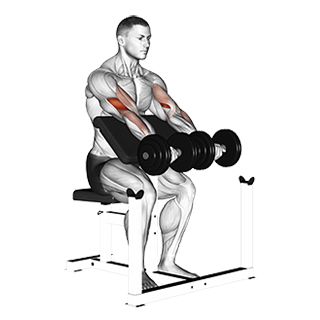
The dumbbell hammer preacher curl is a very useful exercise that targets the brachioradialis, brachialis, and bicep muscles.
More of the brachioradialis and brachialis are worked while using a hammer/neutral grip than the biceps. It’s an excellent take on the preacher’s curl.
How To Do
- Make sure your arms are parallel to the top of the preacher’s bench seat by adjusting the seat.
- With a neutral or hammer grip, hold a dumbbell in each hand and lay your arm fully down against the bench.
- Until you reach the top position, slowly curl the dumbbells up towards your head while maintaining your arms resting on the bench.
- Hold for a count
- Repeat the desired number of repetitions.
Tips
- For best results, perform this exercise slowly and carefully.
- To avoid tearing your biceps, avoid locking out your elbows.
Close Grip Pull-Up
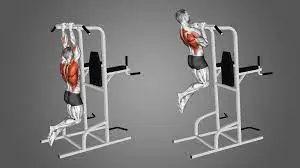
One exercise for strength training is the close-grip pull-up. This is a bodyweight exercise that will give your back and biceps major muscle gain. To further target your long-head biceps, use a close grip.
Although this exercise isn’t specifically targeted at the biceps like the others, compound motions like these are some of the finest ones for your biceps.
The neutral grip pull-up is our choice because it best targets your lengthy head when it comes to the biceps.
How To Do
- Holding onto the double pull-up bars, extend your arms and shoulders fully.
- You have three options: bend your knees, keep your legs straight, or cross your feet.
- Breathe out as you raise your chin above the bars by pulling your body up. Hold for two counts.
- As you bend over and extend your arms and shoulders, take a breath.
- Repeat the desired number of reps.
Tips
- Lower the elbow to nearly full extension, being careful not to lock it out entirely.
Common Mistake During Long Head Bicep Exercises
Below mistakes are frequently made by individuals trying to build bigger biceps faster. many times this has to do with the association of their biceps training plan, and other times it is in the performance of individual biceps exercises.
- Lifting Too Much Weight: People too often take really heavy weight off the rack or use dumbbells and kettlebells that are too heavy for the exercise they are doing.
- Improper Form: When doing weight training with biceps, make sure to put the body in natural alignment. While performing bicep curls, your shoulders should be set and stable to the side along with the elbows which should be a hinge joint.
- Letting The Elbows Flare Out: Most individuals concentrate too much on the upper arms and ignore where their elbows go during the training. When you raise the weight, note that the elbows are being flexed.
- Do not Aim for Muscle Failure: Fatiguing your biceps muscles before you begin your main training practice can be very useful, but do not try to induce complete muscle failure when you are only targeting the biceps.
- Training Too Repeatedly: Over-training your biceps is another error that should be avoided. If you like to build your biceps without compromising on arm strength, you must give some breaks to the bicep exercise.
- Tempo is high: Avoid rapid implementation at the beginning of the exercise. Maintaining the form and constant speed is more necessary to allow the muscles to work up and then gradually burn.
FAQ
Does the long head exercise lead to a wider bicep?
It was not until I began mainly on the long head that I began to see a significant improvement in the overall width of my biceps since the outer head was now larger. With 42% responding with the short head and 58% with the long head. So it is clear that the long head does tend to be less developed with others as well.
How do you hold up long-head bicep curls?
To gain strength and mass, the main emphasis of this exercise is the long head of the biceps. Use an overhand grip on a barbell that is shoulder-width apart to do this activity. Take a tall posture with your feet shoulder-width apart. Then, progressively improve the weight to shoulder level.
What is the bicep’s long head’s weakness?
Biceps tendinitis is a weakness of the biceps tendon. Biceps tendinitis is the condition of an irritation or inflammation of the biceps tendon. The long head of the biceps tendon, so named because of its sturdy, cord-like form, attaches the biceps muscle to the bone in the shoulder socket. A common sign of biceps tendinitis is discomfort and weakness at the front of the shoulder.
Can you grow biceps easily?
It usually takes 6 to 8 weeks for you to notice a difference in the way your arms look. You should usually start to notice more noticeable results at about the 12-week point, especially if you didn’t have a lot of muscle mass in that area to begin with!
References
- Luna, D. (2023, April 13). 6 Best long head bicep Exercises: for bigger peaks! Inspire US. https://www.inspireusafoundation.org/long-head-bicep-exercises/
- Set, S. F. (n.d.). 8 Best long head bicep exercises for huge Peaks. SET FOR SET. https://www.setforset.com/blogs/news/long-head-bicep-exercises
- Builtwithscdev. (2022, August 22). Long head biceps exercises. Built with Science. https://builtwithscience.com/workouts/long-head-biceps-exercises/
- Speck, C. (2020, November 17). 5 Best long head bicep exercises for huge Peaks. Fitplan Blog. https://blog.fitplanapp.com/5-best-long-head-bicep-exercises-for-huge-peaks/g





